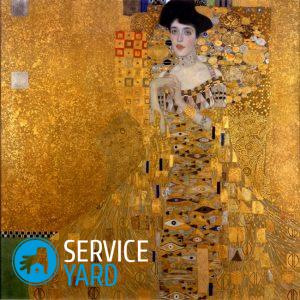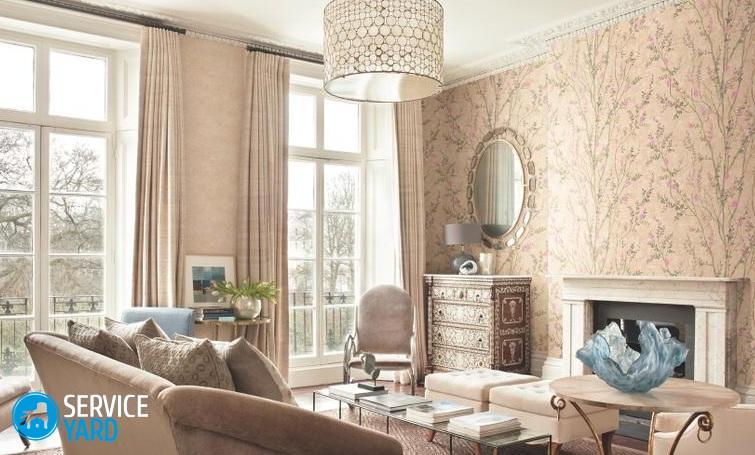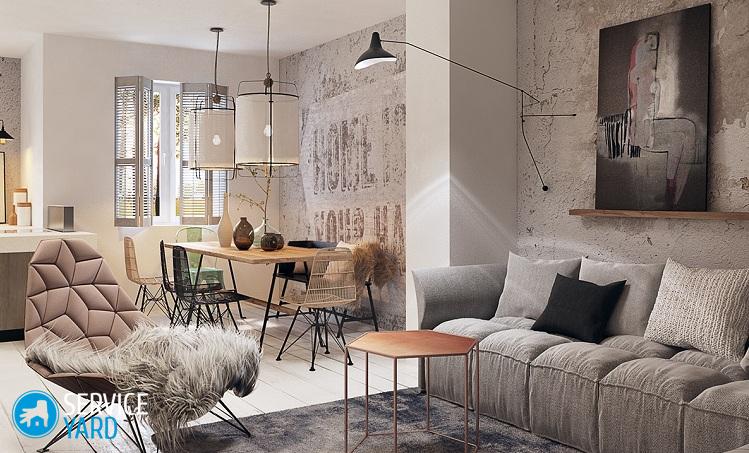Raw plaster painting with water colors

Water-based painting on wet stucco is called a mural. Another name is used - Alfresco. This is one of the traditional ways of decorating living spaces. However, walls and ceilings in public buildings - for example, in cathedrals, were designed in this way. It seems to you that it is very difficult and accessible only to a professional artist? This is not entirely true. Painting on raw plaster with water-based paints is, of course, not the easiest thing, but with a great desire and some skills it is quite affordable. You will now learn how to paint your apartment.
to contents ↑Two methods of decorating walls
If you are interested in painting on raw plaster and you dream about a house where the walls will be decorated with frescoes, you will be interested to know that there are two ways to paint on plaster:
- for sure, the fresco already known to you, that is, a picture made on raw plaster;
- Alsecco - painting on dry plaster.
Each option has its own advantages and disadvantages. The frescoes look more elegant. They have one misfortune - a painting made in this technique is very capricious, it is sensitive to moisture and does not respond very well to various pollutants. So frescoing, for example, the kitchen is definitely not worth it. Such a work will feel bad on the outer wall of the house. Of course, in some countries this technique is used to create monumental street works, but only where weather conditions allow.
Alsecco in this sense is much more promising:
- moisture does not deteriorate;
- some air pollution is neutral;
- retains color longer.
That is, a work made in this technique can decorate any room in the apartment, as well as the facade. It’s hard to say which option is harder. In any case, preparation of walls, paints, and a sketch is required.
to contents ↑What are the colors?
To make such a painting on plaster, you can use different compositions:
- mixed in raw eggs;
- on a glue basis;
- on the water.
Pigments kneaded on a raw egg are a classic of the genre; they used such paints in the Middle Ages. To this day, they have not lost popularity, and if they are not used as often as water, it is solely because cooking is a rather laborious process. Glue and water paints are sold almost ready-made.
to contents ↑Important! Natural materials are added as pigments. As a rule, the materials are not toxic, so you can decorate the wall in this way in any room, including the nursery.
Alfresco and Alsecco
Alsecco paintings differ from frescoes in that the colors look more vibrant and saturated, and the picture does not age so quickly. And the dry plaster painting is done more slowly, but the fresco needs to be rushed and have time to do everything until the plaster dries. Of course, it is much easier to draw on a dry wall than on a raw one, and not only one artist can work, but a whole company according to one sketch.
Alsecco's disadvantages
The main disadvantage of this type of wall painting is that quite a lot of time is required. This is not so important if you just want to express your vision of the world.But for those who are concerned about the prompt creation of an elegant interior, this method is hardly suitable. If you order a painting to an artist, the timing should be discussed before he gets down to work.
to contents ↑Important! When working in the Alsecco technique, paint on each fragment is applied in several layers, while the next layer is applied when the previous one is already dry.
Choose a plot
Painting on the wall is a luxury item, and you are unlikely to want to rewrite it every year. Therefore, when choosing a plot, consider several points:
- the plot should not be aggressive;
- Do not place war, catastrophe scenes in apartments;
- it is better if the image is neutral, suitable for different rooms;
- everything that is painted on the wall should create a calm and joyful mood.
Important! This applies not only to painting on dry or wet plaster, but also to any paintings that you bring to the house. Of course, there are situations when it is necessary to keep military scenes at home or the image of a falling plane. But such objects should not be large and be in full view of everyone.
Fit:
- pastoral scenes;
- sea, forest and mountain landscapes;
- household plots;
- illustrations for fairy tales and legends;
- types of Cosmos;
- still lifes with fruits and flowers.
Cooking the wall
Regardless of whether you will paint your room yourself or invite an artist, whether it is a fresco or alsecco, the wall must be prepared. It must meet a number of requirements:
- for alsecco, the surface should be almost perfectly flat, for a mural - on the contrary:
- it should not have falling off pieces of plaster, hollows, chips, stratifications;
- color should be light and the same across the surface.
Therefore, the preparation of the wall is reduced to the usual repair, only performed more thoroughly than under wallpaper or under painting. You will need:
- hammer drill;
- sharp knife;
- water;
- putty;
- priming;
- grinding machine or skin;
- tools for decorating.
Before you sketch watercolors, you have to make a thorough repair. For dry plaster painting, it looks like this:
- Remove all the old coating so that not a single scrap of wallpaper or a piece of tile remains - this is what you need a knife and a puncher for.
- To beat off pieces of old plaster, which are held loose.
- Close up all cracks and chips.
- Sand the wall (at this stage it is not necessary to achieve an ideal surface, you just need to remove the most noticeable irregularities).
- Plaster the wall.
- Apply a coat of soil.
- Allow the primer to dry.
- You can apply another layer of soil.
to contents ↑Important! In construction stores you will find soil of different colors, it is better to choose the lightest that you can find.
Raw stucco painting
The mural is not suitable for any room. The most important thing is that the room should not have high humidity and sudden changes in temperature, so this method of wall decoration is clearly not suitable for the kitchen. The fresco is also not very suitable for the hallway, where even the most tidy hosts constantly get street dirt.
- living room;
- a bedroom;
- cabinet;
- the library.
A picture of raw plaster is done like this:
- First of all, light tones are applied.
- Each subsequent layer becomes darker - while dark areas do not necessarily completely overlap light ones.
Wall features
Painting on wet plaster with paints diluted on water, as well as tempera or any other, requires a special relationship to the wall itself. It must be prepared differently than for other types of decoration. The plaster is applied special, it includes:
- brick chips;
- linen threads, they are also called hemp;
- very high-quality lime;
- water.
Brick chips allow the surface to dry more slowly than usual, as the particles retain water perfectly.As for lime, the best one that can be found is taken and diluted with water until the process is over. Flax fiber is needed so that the material becomes more durable and does not crack.
Important! Real plaster for real murals takes a very long time - at least a year.
The manufacturing process looks like this:
- Pour lime into a barrel.
- Start pouring water, only carefully - a lot of heat is released during a chemical reaction.
- Put it all to stand on time - it is better if for a year, and the solution should not dry out. Not everyone has this opportunity, so now the exposure time is usually reduced to an acceptable one - a month or even a week.
- Add fillers - brick chips and chopped fibers, and mix the solution until smooth.
Keep in mind that slaking lime is a rather dangerous procedure.
Important! The liquid is burning, you can not allow it to fall on the mucous membranes and open areas of the body. In case of contact with eyes, this compound may even cause complete blindness.
It is best to carry it out as they usually work with chemicals, that is, use:
- points:
- respirator;
- protective gloves.
to contents ↑Important! Brick chips can be replaced with coarse river sand, well washed.
Preparing the wall for the mural
The ideal place for painting on raw plaster is a brick wall. It does not need to make additional irregularities, they already exist. You will have to tinker with the concrete surface. In order for the wet stucco painting to hold firmly, the surface must be prepared very well. The fundamental difference from preparing the base for alsecco - you do not need to grind the wall to the ideal state. Chips and potholes are needed so that the solution adheres better to the surface. Therefore, we do the following:
- Completely remove the old finish - as carefully as for alsecco.
- We remove all the old plaster.
- We remove dirt, also if possible qualitatively.
- We remove the dust.
- Wet the wall.
- We stand the day.
- Wet again an hour and a half before work.
- We apply 2-3 layers of soil.
- Apply a base coat of plaster and let it dry.
- We make 2-3 mm deepenings on it.
- We put a finishing layer on which there will be a painting - it must remain moist during operation.
Sometimes plaster is applied in 6-7 layers. In this case, it is necessary that each subsequent layer is thinner than the previous one.
to contents ↑Important! If the plaster is applied in two layers, the first layer should remain wet when you start applying the second.
How is wet plaster painting done?
As with any other work, the artist first thinks up what he will draw. He can even make a small sketch. This is a preliminary stage. Then the following happens:
- A large drawing is made - such as it will be on the wall.
- The picture is cut into fragments - for example, the contours of figures, buildings.
- Cut fragments are superimposed on the surface, fixed in any convenient way.
- Contours and borders of each color are outlined.
- Each fragment is filled with a certain color, and this must be done quickly.
- Shadows are applied.
- First, light areas are applied.
- Then the darkest contours and spots are applied.
- The final stage is the transition from dark to light.
- At the end of the work, a plaster cut with an external bevel is made.
- The resulting space is filled with an additional layer of plaster so that the seam is not noticeable.
- Repeated painting is done strictly along the contours of the first.
- The masterpiece is left alone for about a week or a little more, at which time it is better not to touch it at all.
In this case, it is necessary to take into account the peculiarities of paints, which are usually used for painting on raw plaster. When the wall dries, the colors become lighter. The technique is complex, and different nuances arise during painting. For example, it may happen that a certain section is not good - it is highlighted in color or the contours are not the same as you would like, cracked or peeling in the process.In this case, the damaged area is cut off, the wall is primed again, a fragment of the drawing is applied and everything is prescribed again. But the work must be very high quality so that the seams are not noticeable.
to contents ↑Important! Life-size drawing must be done in color.
Stock footage
In a word, anyone who has a desire to paint can decorate their home with a fresco or alsecco. If you are not confident in yourself, it is better to invite a professional. But regardless of whether you will paint the wall yourself or if the invited artist will do it, the landlord must know the features of this work and be able to prepare for it.
- How to choose a vacuum cleaner taking into account the characteristics of the house and coatings?
- What to look for when choosing a water delivery
- How to quickly create comfort at home - tips for housewives
- How to choose the perfect TV - useful tips
- What to look for when choosing blinds
- What should be running shoes?
- What useful things can you buy in a hardware store
- Iphone 11 pro max review
- Than iPhone is better than Android smartphones





